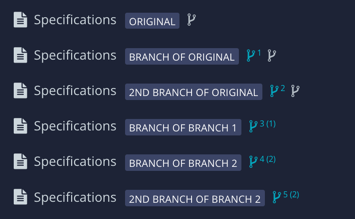Zweigsymbole und -nummern
Paligo verwendet Symbole, Beschriftungen und Zahlen, um anzuzeigen, ob der Inhalt eine Verzweigung und/oder eine Quelle für andere Verzweigungen ist. In der folgenden Abbildung ist beispielsweise ein Topic „Spezifikationen“ mit einem grauen Symbol versehen, um anzuzeigen, dass es verzweigt ist. Die verzweigte Version des Topics hat ein blaues Symbol mit der Nummer 1, um anzuzeigen, dass es sich um die erste Verzweigung handelt.

Ein Beispiel für ein ursprüngliches Topic und die erste Verzweigung dieses Topics.
In den folgenden Abschnitten erklären wir, was die verschiedenen Verzweigungssymbole und -nummern bedeuten.
Graues Verzweigungssymbol
Das graue Verzweigungssymbol zeigt an, dass die Publikation oder das Topic verzweigt wurde. Es handelt sich um die Originalversion („übergeordnet“) einer anderen Verzweigung.
Blaues Verzweigungssymbol
Das blaue Verzweigungssymbol zeigt an, dass es sich bei der Publikation oder dem Topic um eine „untergeordnete“ Verzweigung handelt. Es handelt sich um eine andere Version einer „übergeordneten“ Publikation oder eines Topics.
Graue und blaue Verzweigungssymbole zusammen
Ein Topic oder eine Publikation kann sowohl ein graues Verzweigungssymbol als auch ein blaues Verzweigungssymbol haben.
In diesem Szenario ist die Verzweigung sowohl eine „übergeordnete“ als auch eine „untergeordnete“ Verzweigung:
Das blaue Verzweigungssymbol zeigt an, dass diese Verzweigung aus einer bestehenden Verzweigung, einem Original-Topic oder einer Original-Publikation erstellt wurde. Es handelt sich um eine „untergeordnete“ Verzweigung.
Das graue Verzweigungssymbol zeigt an, dass diese Verzweigung auch eine „übergeordnete“ ist. Jemand hat eine andere Verzweigung aus dieser Verzweigung erstellt.
Die Zahlen neben den Symbolen zeigen die Beziehung der Verzweigung zum „ursprünglichen“ Topic oder zur „ursprünglichen“ Publikation sowie zu anderen Verzweigungen an. Weitere Informationen zur Nummerierung und ein Beispiel für die grauen und blauen Verzweigungssymbole finden Sie unter Zahlen neben den Verzweigungssymbolen.
Zahlen neben den Verzweigungssymbolen
Paligo verwendet Zahlen neben den Verzweigungssymbolen, um die Beziehung der Verzweigung zum ursprünglichen Inhalt und auch zu anderen Verzweigungen anzuzeigen.
Je nachdem, wie eine Verzweigung erstellt wurde, kann sie Folgendes haben:
Eine einzige Zahl
Dies zeigt an, dass es sich bei dem Topic oder der Publikation um eine „untergeordnete“ Verzweigung handelt. Wenn es sich um 1 handelt, ist es die erste Verzweigung, die vom Original erstellt wurde, wenn es sich um 2 handelt, ist es die zweite Verzweigung und so weiter.

Zwei Zahlen, eine in Klammern
Die erste Zahl zeigt an, dass es sich bei dem Topic oder der Publikation um eine „untergeordnete“ Verzweigung handelt. Wenn es sich um 1 handelt, ist es die erste Verzweigung, die vom Original erstellt wurde, wenn es sich um 2 handelt, ist es die zweite Verzweigung und so weiter.
Die zweite Zahl (in Klammern) wird nur angezeigt, wenn Sie aufeinanderfolgende Verzweigungen aktiviert haben (siehe Verzweigungsmodus auswählen). Es wird angezeigt, welche Verzweigung die „übergeordnete“ Verzweigung dieser Verzweigung ist.

Beispielsweise ist in der Abbildung die erste Zahl 3 und die Zahl in Klammern 1. Dies bedeutet, dass diese Verzweigung die dritte Verzweigung der ursprünglichen „übergeordneten“ ist und aus Verzweigung 1 erstellt wurde.
Schauen wir uns eine Reihe von Verzweigungen an, die aus einem Topic „Spezifikationen“ erstellt wurden.

Von oben nach unten:
Das ursprüngliche Topic „Spezifikationen“ hat ein graues Verzweigungssymbol. Dies zeigt an, dass es weitere Verzweigungen zu diesem Topic gibt. Sie ist ein übergeordnetes Element.
Die erste Verzweigung des ursprünglichen Topics „Spezifikationen“ hat ein blaues Verzweigungssymbol mit der Nummer 1. Sie ist das erste untergeordnete Element der Originalversion. Sie hat auch ein graues Verzweigungssymbol, was bedeutet, dass sie auch selbst ein übergeordnetes Element ist. Andere Verzweigungen basieren auf dieser Verzweigung.
Die zweite Verzweigung des ursprünglichen Topics „Spezifikationen“ hat ein blaues Verzweigungssymbol mit der Nummer 2. Sie ist das zweite untergeordnete Element der Originalversion. Sie hat auch ein graues Verzweigungssymbol, um anzuzeigen, dass sie auch selbst ein „untergeordnetes“ Element ist.
Die dritte Verzweigung wurde aus der ersten Verzweigung heraus gebildet. Sie hat ein blaues Verzweigungssymbol mit der Zahl 3, um anzuzeigen, dass sie die dritte Verzweigung ist, die aus dem ursprünglichen Topic stammt. Sie hat auch eine zweite Zahl (1), um anzuzeigen, dass es sich um ein „untergeordnetes“ Element von Verzweigung 1 handelt.
Der vierte Verzweigung wurde aus der zweiten Verzweigung heraus gebildet. Sie hat ein blaues Verzweigungssymbol mit der Zahl 4, um anzuzeigen, dass sie die vierte Verzweigung ist, die aus dem ursprünglichen Topic stammt. Sie hat auch eine zweite Zahl (2), um anzuzeigen, dass es sich um ein „untergeordnetes“ Element von Verzweigung 2 handelt.
Der fünfte Verzweigung wurde aus der zweiten Verzweigung heraus gebildet. Sie hat ein blaues Verzweigungssymbol mit der Zahl 5, um anzuzeigen, dass sie die fünfte Verzweigung ist, die aus dem ursprünglichen Topic stammt. Sie hat auch eine zweite Zahl (2), um anzuzeigen, dass es sich um ein „untergeordnetes“ Element von Verzweigung 2 handelt.
Anmerkung
Der Text, wie „VERZWEIGUNG VON VERZWEIGUNG 2“ und „2. VERZWEIGUNG VON VERZWEIGUNG 2“, sind Beschriftungen. Wir haben sie für dieses Beispiel hinzugefügt, um es verständlicher zu machen. Sie können Ihren Beschriftungen eigene Verzweigungen hinzufügen (und diese sind manchmal auch bei regulären, nicht verzweigten Inhalten nützlich).